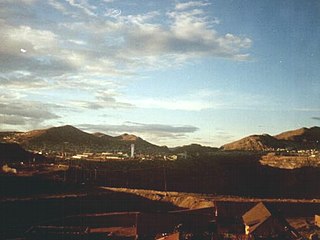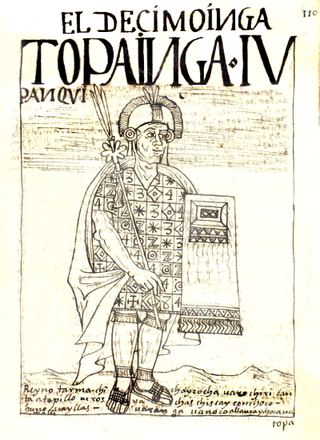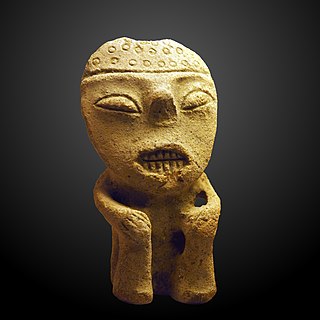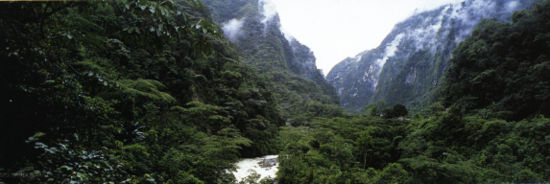
Cajamarca, also known by the Quechua name, Kashamarka, is the capital and largest city of the Cajamarca Region as well as an important cultural and commercial center in the northern Andes. It is located in the northern highlands of Peru at approximately 2,750 m (8,900 ft) above sea level in the valley of the Mashcon river. Cajamarca had an estimated population of about 226,031 inhabitants in 2015, making it the 13th largest city in Peru.

Potosí, known as Villa Imperial de Potosí in the colonial period, is the capital city and a municipality of the Department of Potosí in Bolivia. It is one of the highest cities in the world at a nominal 4,090 m (13,420 ft). For centuries, it was the location of the Spanish colonial silver mint. A considerable amount of the city's colonial architecture has been preserved in the historic center of the city, which—along with the globally important Cerro Rico de Potosí—are part of a designated UNESCO World Heritage Site.

Cerro de Pasco is a city in central Peru, located at the top of the Andean Mountains. It is the capital of both the Pasco Province and the Department of Pasco, and an important mining center of silver, copper, zinc and lead. At an elevation of 4,330 metres (14,210 ft), it is one of the highest cities in the world, and with a population of 58,899, it is the highest or the second highest city with over 50,000 inhabitants. The elevation reaches up to 4,380 metres or 14,370 feet in the Yanacancha area. The city has a very intense cold climate and it is connected by road and by rail to the capital Lima, 300 kilometres or 190 miles away. Its urban area is formed by the districts of Chaupimarca, Yanacancha and Simón Bolívar.

Topa Inca Yupanqui or Túpac Inca Yupanqui, also Topa Inga Yupangui, translated as "noble Inca accountant," was the tenth Sapa Inca (1471–93) of the Inca Empire, fifth of the Hanan dynasty. His father was Pachacuti, and his son was Huayna Capac. Topa Inca belonged to the Qhapaq panaca. His qoya was his older sister, Mama Ocllo.

The Urubamba River or Vilcamayo River is a river in Peru. Upstream it is called Vilcanota River. Within the La Convención Province, the name changes to Urubamba. A partially navigable headwater of the Amazon River, the Urubamba rises in the Andes to the southeast of Cusco. It originates on the slopes of Cunurana in the Puno Region, Melgar Province, near the La Raya pass. It flows north-north-west for 724 km (450 mi) before coalescing with the Tambo River to form the Ucayali River.
A coblyn is a mythical gnome-like creature that is said to haunt the mines and quarries of Wales and areas of Welsh settlement in America.

The Chullachaki or Chullachaqui, also known as the Shapishico, is a mythical forest creature of the Peruvian and Brazilian Amazonian jungle.

Lake Junin or Chinchaycocha is the largest lake entirely within Peruvian territory. Even though Lake Titicaca has a much larger area, its eastern half is located on Bolivian territory. Lake Junin is an important birdwatching destination in the country.

The Andean cock-of-the-rock, also known as tunki (Quechua), is a large passerine bird of the cotinga family native to Andean cloud forests in South America. It is the national bird of Peru. It has four subspecies and its closest relative is the Guianan cock-of-the-rock.
The term Peruvian literature not only refers to literature produced in the independent Republic of Peru, but also to literature produced in the Viceroyalty of Peru during the country's colonial period, and to oral artistic forms created by diverse ethnic groups that existed in the area during the prehispanic period, such as the Quechua, the Aymara and the Chanka South American native groups.
The High Academy of the Quechua Language, or AMLQ, is a Peruvian organization dedicated to the teaching, promotion, and dissemination of the Quechua language.
A previously unknown Inca settlement, Quriwayrachina or Quri Wayrachina, was found in the Willkapampa mountain range in the Cusco Region of Peru in 2001. The site lies in the Santa Teresa District of the La Convención Province, north of the archaeological site of Choquequirao and west of the mountains Kiswar and Quriwayrachina (Corihuayrachina), on a mountain named Victoria. Close to nearby ancient Inca mines, the surrounding hills are covered with the littered stones from more than 200 structures in this Inca outpost.

T'anta wawa is a type of sweet roll shaped and decorated in the form of a small child or infant. They are generally made of wheat and sometimes contain a sweet filling. They are made and eaten as part of ancestral rites in Andean regions of Bolivia, Ecuador, Peru, the south of Colombia, and the north of Argentina, mainly on All Souls' Day, but also as part of agricultural festivals, carnivals, and Christmas.

Andean Spanish is a dialect of Spanish spoken in the central Andes, from southern Colombia, with influence as far south as northern Chile and Northwestern Argentina, passing through Ecuador, Peru, and Bolivia. While similar to other Spanish dialects, Andean Spanish shows influence from Quechua, Aymara, and other indigenous languages, due to prolonged and intense language contact. This influence is especially strong in rural areas.

The pacha was an Incan concept for dividing the different spheres of the cosmos in Incan mythology. There were three different levels of pacha: the hana pacha, hanan pacha or hanaq pacha, ukhu pacha, and kay pacha. The realms are not solely spatial, but were simultaneously spatial and temporal. Although the universe was considered a unified system within Incan cosmology, the division between the worlds was part of the dualism prominent in Incan beliefs, known as Yanantin. This dualism found that everything which existed had both features of any feature.

Tintaya is a Peruvian copper mine. It was owned by the Swiss corporation Xstrata. The mine is located in the Cusco Region, Espinar Province, Yauri District, southeast of Yauri. The ore processing rate is at 200,000 tonnes per year and the construction phase of the mine asked for US$1.5 billion investment. Bechtel was hired for feasibility and EPCM for the mine.
Muki is a mountain in the Andes of Peru, about 4,600 m (15,100 ft) high. It is located in the Lima Region, Oyón Province, Oyón District. Muki lies northwest of the mountain named Luliqucha.
Muki is a mountain in the Cordillera Central in the Andes of Peru which reaches a height of approximately 4,800 metres (15,748 ft). It is located in the Lima Region, Yauyos Province, Tanta District. Muki lies northwest of Paqarin Pawka at a lake named Ch'uspiqucha.
Muki is a mountain in the Cordillera Central in the Andes of Peru which reaches a height of approximately 4,800 metres (15,748 ft). It is located in the Lima Region, Yauyos Province, on the border of the districts of Huancaya and Tomas.












